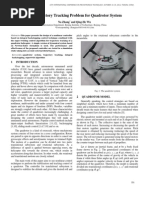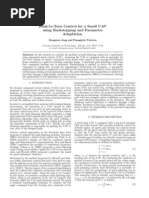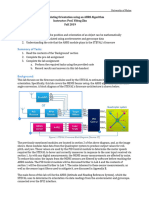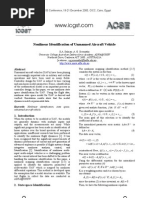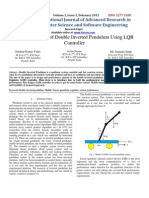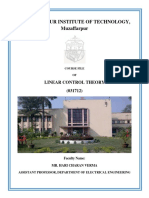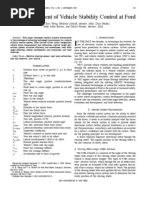198
198
Uploaded by
Augusto César SousaCopyright:
Available Formats
198
198
Uploaded by
Augusto César SousaCopyright
Available Formats
Share this document
Did you find this document useful?
Is this content inappropriate?
Copyright:
Available Formats
198
198
Uploaded by
Augusto César SousaCopyright:
Available Formats
http://dx.doi.org/10.5540/DINCON.2011.001.1.
0198
778
A NEURAL NETWORK CONTROL BASED ON DIFFERENTIAL FLATNESS FOR A QUADROTOR
Sebastio S. Cunha Jr 1, Benjamas Panomruttanarug 2, Hamdam Al-Fazari 3, Felix Mora-Camino 4
2 1 Federal University of Itajuba, Itajuba, Brazil, sebas@unifei.edu.br King Mongkuts University of Technology Thonburi, Bangkok, Thailand, benjamas.pan@kmutt.ac.th 3 Oman Technological College, Oman, alfazari03@hotmail.com 4 French Civil Aviation Institute, Toulouse, France, felix.mora@enac.fr
Abstract: In this paper, a control strategy for a quadrotor using neural network and differential flatness is proposed. Since attitude and altitude of the quadrotor are differential flat outputs for its flight dynamics, neural networks are used to perform the inversion of the flight dynamics and provide the nominal input control for the quadrotor. Errors in modeling approximations and perturbations are fed back into an additional closed loop control structure in order to assure tracking accuracy. Numerical simulations are displayed for analysis. Key-words: Artificial Neural Flatness, Non-linear Control. 1. INTRODUCTION In the last years studies in unmanned aerial vehicles, in special rotor powered systems, have been developed since they appear to present simultaneously hovering, orientation and trajectory tracking capabilities at reasonable cost [1], [2], [3], [4], [5]. These flying devices have been introduced in many civilian and military applications and new configurations and control laws must be developed to assure their applicability to new missions. The flight mechanics of the quadrotor are highly nonlinear and different control approaches (sliding mode control, backstepping control, non-linear inverse control) have been considered with success to achieve trajectory tracking. However, the effective practical realisation of these control solutions depends on the availability of accurate measurement systems dedicated to the estimation of the angular rates, attitude and heading angles as well as the inertial position and speed components of the quadrotor. To overcome these specific difficulties and obtain a practical control system, this paper proposes the use of a neural network control structure based on differential flatness. Differential flatness [6] has provided new opportunities to design advanced control schemes for non-linear systems as a quadrotor and some applications of this technique in the field of aerospace have been performed [7], [8], [9]. Here, the differential flatness property of quadrotor attitude and altitude dynamics is displayed and a feed-forward backpropagation neural network is used to invert the flight Network, Differential
dynamics and calculate the nominal input to the system according to the desired output in order to track heading and altitude trajectories. Tracking errors, originated in modelling approximations and perturbations, are fed back into an additional closed loop control structure to assure tracking accuracy and to eliminate drift phenomena. In the remainder, the adopted formulation of the flight dynamics model of the quadrotor is first presented, followed by a brief description about the differential flatness approach applied to the quadrotor. A control structure employing neural network is presented and numerical simulations are displayed, showing effective results for the proposed control solution. 2. FLIGHT DYNAMICS MODELLING The quadrotor, shown in figure (1), has four propellers in cross configuration where two pairs of propellers turn in opposite directions. By varying the rotor speeds, one can change the lift forces and create motion. Thus, increasing or decreasing evenly the four propellers speeds together generates vertical motion. F1 F4
1
F2 Y {E} Z X
z y
{B}
4
x
F3
mg
Fig. 1. Quadrotor scheme
Changing evenly the 2 and 4 propellers speed conversely produces roll rotation coupled with lateral motion. Pitch rotation and the corresponding lateral motion result
779
A Neural Network Control Based on Differential Flatness for a Quadrotor S. S. Cunha Jr, B. Panomruttanarug, H. Al-Fazari, F. Mora-Camino
from 1 and 3 propellers speed conversely modified. Yaw rotation is more subtle, as it results from the difference in the counter-torque between each pair of propellers. To limit the complexity of the modeling, the following assumptions are adopted [1]: The quadrotor structure is rigid and symmetrical; No wind; Negligible aerodynamic contributions; No ground effect as well as negligible air density effects and very small rotor response times.
which can be expressed analytically as a function of the current state, the current input and its derivatives, while the state and the input vectors can be expressed analytically as a function of Z and a finite number of its derivatives. Then there exists smooth mapping Gx , GU , and Gz are:
( ) & ,...., Z ( ) ) X = G (Z , Z & ,...., Z ( ) ) U = G (Z , Z
Z = G z X ,U ,....,U (nz )
x nx U nx +1
(13) (14) (15)
It is then possible to write simplified rotorcraft flight equations [2]. The moment equations can be written as:
& = (1 / I xx ) [l (F4 F2 ) + k 2 qr ] p
(1) (2) (3)
& = 1 / I yy [l (F1 F3 ) + k 4 pr ] q & = (1 / I zz ) [k (F2 F1 + F4 F3 )] r
where n z and n x are integer numbers. Vector Z is called a flat output for the nonlinear system given by equation (12). Although until today there is no systematical way to determine flat outputs and eventually to prove its uniqueness, the flat outputs usually possess some physical meanings. The explicit flatness property is of particular interest for the solution of control problems when physically meaningful flat outputs can be related with their objectives. The motion equations of the rotorcraft can be written in non-linear state form as:
where p, q, r are the components of the body angular velocity, with k 2 = I zz I yy / I xx , k 4 = (I xx I zz ) / I yy ,
I xx , I yy and I zz being the moments of inertia in body-axis.
The Euler equations are given by:
& = f (x, u ) x
where:
(16) (17) (18) (19) (20) (21) (22)
& = p + tan ( ) [sin ( ) q + cos( ) r ] & = cos( ) q + sin ( ) r & = (sin ( ) q + cos( )r ) / cos( )
(4) (5) (6)
&, y &, z & ) x = ( p, q, r , , , , x, y , z , x
u = u p , u q , u , u z
u p = F4 F2 u q = F1 F3
where , , and are respectively the pitch, bank and heading angles. The acceleration of the centre of gravity, taken directly in the local Earth reference frame, is such as:
u = F2 F1 + F4 F3 u z = F1 + F2 + F3 + F4
& & = (1 / m )[cos( ) sin ( ) cos( ) + sin ( ) sin ( ) F dx] (7) x & & = (1 / m )[sin ( )sin ( )cos( ) cos( )sin ( ) F dy ] (8) y & & = g (1 / m ) [cos( ) cos( ) F + dz ] z
(9)
Considering here the output vector Z = ( , , , z ) the inversion of the Euler equations (4), (5) and (6) provides expressions such as:
where x , y and z are the centre of gravity coordinates, m is the total mass of the quadrotor, dx , dy and dz are the drag forces and:
&, & p = p ,
(23) (24) (25)
&, & q = q , ,
F = F1 + F2 + F3 + F4
with the constraints:
(10)
( ) &, &) r = r ( , ,
& sin ( ) & p =
0 Fi Fmax
i {1,2,3,4 }
or more specifically: (11) (26) (27) (28)
3. DIFFERENTIAL FLATNESS According to [2], a general nonlinear system given by:
& + sin ( )cos ( ) & q = cos ( ) & + cos ( )cos ( ) & r = sin ( )
while u can be expressed as:
& = (X ,U ) X
X n , U m
(12)
where is a smooth mapping, is said explicitly flat with respect to the output vector Z , if Z is an m th order vector
&, &, &&, &&, & , &&, z &, & & u = u , , z
(29)
780
By inversion of the set of equations (1), (2), (3) and (9):
additional control
& k 2 qr ) l u p = (I xx p & k 4 pr l uq = I yy q
(30) (31) (32) (33)
& u = I zz r & g ) dz (z & )] (cos ( ) cos ( )) u z = [ m(& z
PD control
gains
Then, it can be concluded that the attitude and heading dynamics as well as the altitude of the rotorcraft are differentially flat when considering the input-output relation between u and Z . 4. A NEURAL NETWORK CONTROL STRATEGY According to section 3, given a desired output (attitude, heading and altitude) of the quadrotor:
Zd
& Z d & & Z
d
ANN
nominal control
SYSTEM
Zr
Fig. 2. Closed loop control structure using neural networks
5. RESULTS Numerical simulations using MATLAB/Simulink have been performed for generating training and validation data for the neural network as well as for the control purposes. Physical parameters of the quadrotor have been adopted in the simulations and the main characteristics of this system are reported in [2]. Here, the chosen control objective is relative to tracking heading and altitude while the attitude of quadrotor remains unchanged ( = 0 and = 0 ). Then, two feed-forward back-propagation neural networks with only one hidden layer have been constructed to perform the inversion of the quadrotor flight dynamics, one for altitude control inversion (u z ) and then other one for heading u .
Z d = (d , d , d , z d )
(34)
the inputs of the system, equation 18, are solutions of the set of equations 30-33 and a causal relationship between the inputs and flat outputs of the system is verified. Since neural networks are well fitted to reproduce causal relations [8], we can use these devices to map the desired output with the flat inputs of the system. Then, a neural network is developed to perform an inversion of the flight dynamics of the quadrotor where the inputs of the neural network are the desired attitude, heading and altitude (equation 34) and its time derivates and where its outputs are the nominal flight control parameters as shown in figure (2). The reason to introduce a neural network control structure based on differential flatness for the quadrotor is to eliminate the need of measurements dedicated to the estimation of various flight variables (angular rates, attitude and heading angles, inertial position and speed) as needed in other non-linear control techniques. Here, the proposed approach requires only to know the desired trajectory and its time derivates, enabling practical applications. However, a control structure using the neural network inversion is open loop and errors originated in modeling approximations, in perturbations and in the training of the neural network should generate drift behavior or worse instability. To fix this problem, an additional closed loop is added to the control structure and the errors are fed back into a PD control unit to insure tracking accuracy and to eliminate drift phenomena. Figure (2) shows the proposed closed loop control structure.
( )
A set of desired heading ( d ) and altitude ( z d ) trajectories have been created to perform the training and validation of neural networks. Figure (3) shows an example of training performance for the two neural sub-networks.
Fig. 3. Training performance for the neural networks
The main characteristics of the neural networks are displayed in table 1.
781
A Neural Network Control Based on Differential Flatness for a Quadrotor S. S. Cunha Jr, B. Panomruttanarug, H. Al-Fazari, F. Mora-Camino Tab. 1. Characteristics of the neural networks
- NN
n of neurons (hidden layer) mean square error activation function Training epochs 20 1.01x10-6 hyperbolic tangent 240.000
z - NN
20 4.90x10-6 hyperbolic tangent 240.000
The effectiveness of the proposed control structure has been evaluated by numerical simulations. Further study will focus in a full state control of the quadrotor engaged in complex 3D/4D trajectory tracking.
REFERENCES
[1]PUB A. Drouin, A.B. Ramos, F. Mora-Camino, Rotorcraft Trajectory Tracking by Non Linear Inverse Control, Proceedings of the 6th DINCON, So Jos do Rio Preto, Brazil, 2007. [2]PUB A. Drouin, T. Miquel, F. Mora-Camino, NonLinear Control Structures for Rotorcraft positioning, AIAA Guidance, Navigation and Control Conference, Honolulu, 2008. [3]DOI M. Bouchoucha, M. Tadjine, A. Tayebi, P. Mllhaupt, Step by Step Robust Nonlinear PI for Attitude Stabilization of Four-Rotor Miniaircraft, Proceedings of the 16th Mediterranean Conference on Control and Automation, Ajaccio, France, 2008. [4]DOI Y. Bouktir, M. Haddad, T. Chettibi, Trajectory Planning for a Quadrotor Helicopter, Proceedings of the 16th Mediterranean Conference on Control and Automation, Ajaccio, France, 2008.
Figure (4) shows tracking results for heading and altitude for an open loop. The results appear to be quite satisfactory for the first instants but drift phenomena is observed and the proposed control structure must be considered to fix it.
Fig. 4. Desired and effective heading angle and altitude in open loop
Then, figure (5) shows the tracking results when an additional PD control structure is placed in parallel with the neural networks. The drift phenomena is eliminated and the quadrotor tracks with high accuracy the desired trajectory. The gains of PD control have been empirically chosen as:
[5]DOI C. Nicol, C.J.B. Macnab, A. Ramirez-Serrano, Robust Neural Network Control of a Quadrotor Helicopter, IEEE, 2008. [6] M. Fliess, J. Lvine, P. Martin, and P. Rouchon, Flatness and Defect of Non-Linear Systems: Theory and Examples, Int. J. Control, Vol. 61, No. 6, pp. 13271361, 1995. [7] L. Lavigne, F. Cazaurang, and B. Bergeon, Modelling of Longitudinal Disturbed Aircraft Model by Flatness Approach, AIAA Guidance, Navigation and Control Conference and Exhibit, USA, 2003. [8]DOI W.C. Lu, R.M. Faye, A.C.B. Ramos, J. Slama, F. Mora-Camino, Neural Inversion of Flight Guidance Dynamics, 7th International Conference on Intelligent Systems Design and Applications, RJ, Brazil, 2007. [9]PUB W.C. Lu, F. Mora-Camino, K. Achaibou, Flight Mechanics and Differential Flatness, DINCON 04, Proceedings of Dynamics and Control Conference, Ilha Solteira, Brazil, 2004.
[G ] =
1 .0 0 .5 0 .5 1 .0
(35)
Fig. 5. Desired heading angle and altitude tracking in closed loop
6. CONCLUSION
In this paper, a neural network control system based on differential flatness applied to a quadrotor has been developed. The differential flatness property of quadrotor was displayed and neural networks were used to invert the flight dynamics and calculate the nominal input to the system in order to track heading and altitude trajectories. Tracking errors, originated in modelling approximations, perturbations and neural networks training were fixed using an additional PD control system.
You might also like
- Design of Active Filters (LPF, HPF) : Aim: ApparatusNo ratings yetDesign of Active Filters (LPF, HPF) : Aim: Apparatus5 pages
- Modeling and Altitude Control of Quad-Rotor UAVNo ratings yetModeling and Altitude Control of Quad-Rotor UAV6 pages
- The Trajectory Tracking Problem For Quadrotor System: Na Zhang and Qing-He WuNo ratings yetThe Trajectory Tracking Problem For Quadrotor System: Na Zhang and Qing-He Wu6 pages
- Robust Tracking Control of A Quadrotor Helicopter Without Velocity MeasurementNo ratings yetRobust Tracking Control of A Quadrotor Helicopter Without Velocity Measurement6 pages
- Clemson University College of Engineering and Science Control and Robotics (CRB) Technical ReportNo ratings yetClemson University College of Engineering and Science Control and Robotics (CRB) Technical Report8 pages
- Design of Asymptotic Second-Order Sliding Mode Control For Satellite Formation FlyingNo ratings yetDesign of Asymptotic Second-Order Sliding Mode Control For Satellite Formation Flying14 pages
- Flight Control Design Using BacksteppingNo ratings yetFlight Control Design Using Backstepping8 pages
- Stability in Hovering Ornithopter FlightNo ratings yetStability in Hovering Ornithopter Flight8 pages
- Actuator Fault Detection System For A Mini-Quadrotor: A. Freddi, S. Longhi and A. MonteriùNo ratings yetActuator Fault Detection System For A Mini-Quadrotor: A. Freddi, S. Longhi and A. Monteriù6 pages
- Extended Linearization Technique: GPS User Position UsingNo ratings yetExtended Linearization Technique: GPS User Position Using4 pages
- Genetic Algorithm Based Optimal Control For A 6-DOF Non Redundant Stewart ManipulatorNo ratings yetGenetic Algorithm Based Optimal Control For A 6-DOF Non Redundant Stewart Manipulator7 pages
- Design of Robust Fuzzy Controllers For Aerospace ApplicationsNo ratings yetDesign of Robust Fuzzy Controllers For Aerospace Applications5 pages
- Madani2006 - Backstepping Control For A Quadrotor HelicopterNo ratings yetMadani2006 - Backstepping Control For A Quadrotor Helicopter6 pages
- Fault Tolerance of A Quadrotor Via Feedback Linearization ApproachNo ratings yetFault Tolerance of A Quadrotor Via Feedback Linearization Approach12 pages
- Sliding Mode Control Strategy For A 6 DOF Quadrotor HelicopterNo ratings yetSliding Mode Control Strategy For A 6 DOF Quadrotor Helicopter7 pages
- Inverse Kinematics Problem (Ikp) of 6-Dof Manipulator by Locally Recurrent Neural Networks (LRNNS)No ratings yetInverse Kinematics Problem (Ikp) of 6-Dof Manipulator by Locally Recurrent Neural Networks (LRNNS)5 pages
- Trajectory Tracking Control of Quadrotor Using MPC and Gaussian Process Regression CompensationNo ratings yetTrajectory Tracking Control of Quadrotor Using MPC and Gaussian Process Regression Compensation12 pages
- Nonlinear Robust Tracking Control of A Quadrotor Uav On: Taeyoung Lee, Melvin Leok, and N. Harris McclamrochNo ratings yetNonlinear Robust Tracking Control of A Quadrotor Uav On: Taeyoung Lee, Melvin Leok, and N. Harris Mcclamroch10 pages
- Time-Domain Vs Frequency-Domain Identification For A Small-Scale HelicopterNo ratings yetTime-Domain Vs Frequency-Domain Identification For A Small-Scale Helicopter18 pages
- Engineering Flight Simulator Using MATLAB, Python and Flight GearNo ratings yetEngineering Flight Simulator Using MATLAB, Python and Flight Gear5 pages
- Bank-to-Turn Control For A Small UAV Using Backstepping and Parameter AdaptationNo ratings yetBank-to-Turn Control For A Small UAV Using Backstepping and Parameter Adaptation6 pages
- Control System Design For Robotic AirshipNo ratings yetControl System Design For Robotic Airship6 pages
- Synchronization of Fractional Chaotic Systems Via Fractional-Order Adaptive ControllerNo ratings yetSynchronization of Fractional Chaotic Systems Via Fractional-Order Adaptive Controller5 pages
- Programming Exercise 3: 3D Controller and Trajectory GenerationNo ratings yetProgramming Exercise 3: 3D Controller and Trajectory Generation10 pages
- Efficient Stripmap SAR Raw Data Generation Taking Into Account Sensor Trajectory DeviationsNo ratings yetEfficient Stripmap SAR Raw Data Generation Taking Into Account Sensor Trajectory Deviations5 pages
- Dynamic Modelling and Experimental Identification of Four Rotors Helicopter ParametersNo ratings yetDynamic Modelling and Experimental Identification of Four Rotors Helicopter Parameters7 pages
- Comparative Study Between The Conventional Regulators and Fuzzy Logic Controller: Application On The Induction MachineNo ratings yetComparative Study Between The Conventional Regulators and Fuzzy Logic Controller: Application On The Induction Machine17 pages
- Car Suspension Control by Indirect Adaptive Interval Type - 2 Fuzzy Neural Network ControlNo ratings yetCar Suspension Control by Indirect Adaptive Interval Type - 2 Fuzzy Neural Network Control10 pages
- Nonlinear Aeroelastic Behavior of Flexible High-Aspect Ratio WingsNo ratings yetNonlinear Aeroelastic Behavior of Flexible High-Aspect Ratio Wings2 pages
- Design of A Distributed Power System Stabiliser: Infinite BusbarNo ratings yetDesign of A Distributed Power System Stabiliser: Infinite Busbar6 pages
- Brescianini Hehn Dandrea Pole AcrobaticsNo ratings yetBrescianini Hehn Dandrea Pole Acrobatics8 pages
- Salman - 2005 - Nonlinear Identification of Unmanned Aircraft VehicleNo ratings yetSalman - 2005 - Nonlinear Identification of Unmanned Aircraft Vehicle3 pages
- Pitch Control System Using LQR and Fuzzy Logic Controller: Nurbaiti@tganu - Uitm.edu - My Fuaad@fke - Utm.myNo ratings yetPitch Control System Using LQR and Fuzzy Logic Controller: Nurbaiti@tganu - Uitm.edu - My Fuaad@fke - Utm.my6 pages
- Implementation of Reduced Induction Machine Fuzzy Logic Control Based On dSPACE-1104 R&D Controller BoardNo ratings yetImplementation of Reduced Induction Machine Fuzzy Logic Control Based On dSPACE-1104 R&D Controller Board9 pages
- Analysis of Limit Cycle Flutter of An Airfoil in Incompressible FlowNo ratings yetAnalysis of Limit Cycle Flutter of An Airfoil in Incompressible Flow13 pages
- Fault Tolerant Control of A Quadrotor UAV Using Sliding Mode ControlNo ratings yetFault Tolerant Control of A Quadrotor UAV Using Sliding Mode Control6 pages
- InTech-Robust Path Following For Uav Using Pure Pursuit GuidanceNo ratings yetInTech-Robust Path Following For Uav Using Pure Pursuit Guidance21 pages
- Generalized PI Control of Active VehicleNo ratings yetGeneralized PI Control of Active Vehicle19 pages
- Missile Roll Control Part IV - Modern Control ApproachNo ratings yetMissile Roll Control Part IV - Modern Control Approach8 pages
- Position Control of A PM Stepper Motor Using Neural NetworksNo ratings yetPosition Control of A PM Stepper Motor Using Neural Networks4 pages
- The Comparison of Sensorless Estimation Techniques For PMSM Between Extended Kalman Filter and Flux-Linkage ObserverNo ratings yetThe Comparison of Sensorless Estimation Techniques For PMSM Between Extended Kalman Filter and Flux-Linkage Observer6 pages
- Multivariable Flight Controller Design For Ultrastick-25e UAVNo ratings yetMultivariable Flight Controller Design For Ultrastick-25e UAV19 pages
- A Model Predictive Controller For Quadrocopter State InterceptionNo ratings yetA Model Predictive Controller For Quadrocopter State Interception7 pages
- Robot Manipulators: Modeling, Performance Analysis and ControlFrom EverandRobot Manipulators: Modeling, Performance Analysis and ControlNo ratings yet
- Modeling of Complex Systems: Application to Aeronautical DynamicsFrom EverandModeling of Complex Systems: Application to Aeronautical DynamicsNo ratings yet
- Student Solutions Manual to Accompany Economic Dynamics in Discrete Time, second editionFrom EverandStudent Solutions Manual to Accompany Economic Dynamics in Discrete Time, second edition4.5/5 (2)
- Islamic University of Technology: EEE 4483 Digital Electronics & Pulse TechniquesNo ratings yetIslamic University of Technology: EEE 4483 Digital Electronics & Pulse Techniques44 pages
- Process Automation and Closed-Loop Control Technology100% (1)Process Automation and Closed-Loop Control Technology56 pages
- Powell, J. David - Workman, Michael L. - Franklin, Gene F. - Solutions Manual For Digital Control of Dynamic Systems-Addison-Wesley (1998)No ratings yetPowell, J. David - Workman, Michael L. - Franklin, Gene F. - Solutions Manual For Digital Control of Dynamic Systems-Addison-Wesley (1998)454 pages
- Full download Design of Control Laws and State Observers for Fixed-Wing UAVs: Simulation and Experimental Approaches 1st Edition Arturo Tadeo Espinoza-Fraire pdf docx100% (1)Full download Design of Control Laws and State Observers for Fixed-Wing UAVs: Simulation and Experimental Approaches 1st Edition Arturo Tadeo Espinoza-Fraire pdf docx50 pages
- Behaviour of P, Pi & Pid Controller From Matlab SimulinkNo ratings yetBehaviour of P, Pi & Pid Controller From Matlab Simulink30 pages
- Neural Networks For Modeling and Identification of The Dough Rising Process Inside An Industrial Proofiing ChamberNo ratings yetNeural Networks For Modeling and Identification of The Dough Rising Process Inside An Industrial Proofiing Chamber6 pages
- Automatic Control and System Theory: Claudio MelchiorriNo ratings yetAutomatic Control and System Theory: Claudio Melchiorri28 pages
- Minimum-Time Path Planning For Autonomous Landing of UAV On Aerial Drone CarrierNo ratings yetMinimum-Time Path Planning For Autonomous Landing of UAV On Aerial Drone Carrier6 pages
- Outline: - Introduction To Signal Flow Graphs - Signal-Flow Graph Models - BD To SFG - Mason's Gain FormulaNo ratings yetOutline: - Introduction To Signal Flow Graphs - Signal-Flow Graph Models - BD To SFG - Mason's Gain Formula22 pages
- 3.Modelling-and-Analysis-for-process-control-Lec 5No ratings yet3.Modelling-and-Analysis-for-process-control-Lec 59 pages
- Advanced Motorcycle Virtual Rider: Vehicle System Dynamics September 2008No ratings yetAdvanced Motorcycle Virtual Rider: Vehicle System Dynamics September 200815 pages
- Optimal Control of Double Inverted Pendulum Using LQR ControllerNo ratings yetOptimal Control of Double Inverted Pendulum Using LQR Controller4 pages
- Selecting The Best Distillation Control Configuration - Skogestad1990No ratings yetSelecting The Best Distillation Control Configuration - Skogestad199012 pages
- Matlab/Simulink Exercise: Digital Filter Design: 2 KHZ 3 KHZ R R FNo ratings yetMatlab/Simulink Exercise: Digital Filter Design: 2 KHZ 3 KHZ R R F6 pages
- Find The State-Space Representation in Phase-Variable Form Using Matlab ANo ratings yetFind The State-Space Representation in Phase-Variable Form Using Matlab A6 pages
- Robust Controller Design Using Multi-Objective Optimization Power Management DesignLineNo ratings yetRobust Controller Design Using Multi-Objective Optimization Power Management DesignLine5 pages
- Current Sensing in Electric Drives A Future and History Based On Multiple InnovationsNo ratings yetCurrent Sensing in Electric Drives A Future and History Based On Multiple Innovations8 pages
- 06me71 - Control Engineering: Dept - of Mechanical Engineering MvjceNo ratings yet06me71 - Control Engineering: Dept - of Mechanical Engineering Mvjce68 pages
- The Development of Vehicle Stability Control at FordNo ratings yetThe Development of Vehicle Stability Control at Ford12 pages
- Design of Active Filters (LPF, HPF) : Aim: ApparatusDesign of Active Filters (LPF, HPF) : Aim: Apparatus
- The Trajectory Tracking Problem For Quadrotor System: Na Zhang and Qing-He WuThe Trajectory Tracking Problem For Quadrotor System: Na Zhang and Qing-He Wu
- Robust Tracking Control of A Quadrotor Helicopter Without Velocity MeasurementRobust Tracking Control of A Quadrotor Helicopter Without Velocity Measurement
- Clemson University College of Engineering and Science Control and Robotics (CRB) Technical ReportClemson University College of Engineering and Science Control and Robotics (CRB) Technical Report
- Design of Asymptotic Second-Order Sliding Mode Control For Satellite Formation FlyingDesign of Asymptotic Second-Order Sliding Mode Control For Satellite Formation Flying
- Actuator Fault Detection System For A Mini-Quadrotor: A. Freddi, S. Longhi and A. MonteriùActuator Fault Detection System For A Mini-Quadrotor: A. Freddi, S. Longhi and A. Monteriù
- Extended Linearization Technique: GPS User Position UsingExtended Linearization Technique: GPS User Position Using
- Genetic Algorithm Based Optimal Control For A 6-DOF Non Redundant Stewart ManipulatorGenetic Algorithm Based Optimal Control For A 6-DOF Non Redundant Stewart Manipulator
- Design of Robust Fuzzy Controllers For Aerospace ApplicationsDesign of Robust Fuzzy Controllers For Aerospace Applications
- Madani2006 - Backstepping Control For A Quadrotor HelicopterMadani2006 - Backstepping Control For A Quadrotor Helicopter
- Fault Tolerance of A Quadrotor Via Feedback Linearization ApproachFault Tolerance of A Quadrotor Via Feedback Linearization Approach
- Sliding Mode Control Strategy For A 6 DOF Quadrotor HelicopterSliding Mode Control Strategy For A 6 DOF Quadrotor Helicopter
- Inverse Kinematics Problem (Ikp) of 6-Dof Manipulator by Locally Recurrent Neural Networks (LRNNS)Inverse Kinematics Problem (Ikp) of 6-Dof Manipulator by Locally Recurrent Neural Networks (LRNNS)
- Trajectory Tracking Control of Quadrotor Using MPC and Gaussian Process Regression CompensationTrajectory Tracking Control of Quadrotor Using MPC and Gaussian Process Regression Compensation
- Nonlinear Robust Tracking Control of A Quadrotor Uav On: Taeyoung Lee, Melvin Leok, and N. Harris McclamrochNonlinear Robust Tracking Control of A Quadrotor Uav On: Taeyoung Lee, Melvin Leok, and N. Harris Mcclamroch
- Time-Domain Vs Frequency-Domain Identification For A Small-Scale HelicopterTime-Domain Vs Frequency-Domain Identification For A Small-Scale Helicopter
- Engineering Flight Simulator Using MATLAB, Python and Flight GearEngineering Flight Simulator Using MATLAB, Python and Flight Gear
- Bank-to-Turn Control For A Small UAV Using Backstepping and Parameter AdaptationBank-to-Turn Control For A Small UAV Using Backstepping and Parameter Adaptation
- Synchronization of Fractional Chaotic Systems Via Fractional-Order Adaptive ControllerSynchronization of Fractional Chaotic Systems Via Fractional-Order Adaptive Controller
- Programming Exercise 3: 3D Controller and Trajectory GenerationProgramming Exercise 3: 3D Controller and Trajectory Generation
- Efficient Stripmap SAR Raw Data Generation Taking Into Account Sensor Trajectory DeviationsEfficient Stripmap SAR Raw Data Generation Taking Into Account Sensor Trajectory Deviations
- Dynamic Modelling and Experimental Identification of Four Rotors Helicopter ParametersDynamic Modelling and Experimental Identification of Four Rotors Helicopter Parameters
- Comparative Study Between The Conventional Regulators and Fuzzy Logic Controller: Application On The Induction MachineComparative Study Between The Conventional Regulators and Fuzzy Logic Controller: Application On The Induction Machine
- Car Suspension Control by Indirect Adaptive Interval Type - 2 Fuzzy Neural Network ControlCar Suspension Control by Indirect Adaptive Interval Type - 2 Fuzzy Neural Network Control
- Nonlinear Aeroelastic Behavior of Flexible High-Aspect Ratio WingsNonlinear Aeroelastic Behavior of Flexible High-Aspect Ratio Wings
- Design of A Distributed Power System Stabiliser: Infinite BusbarDesign of A Distributed Power System Stabiliser: Infinite Busbar
- Salman - 2005 - Nonlinear Identification of Unmanned Aircraft VehicleSalman - 2005 - Nonlinear Identification of Unmanned Aircraft Vehicle
- Pitch Control System Using LQR and Fuzzy Logic Controller: Nurbaiti@tganu - Uitm.edu - My Fuaad@fke - Utm.myPitch Control System Using LQR and Fuzzy Logic Controller: Nurbaiti@tganu - Uitm.edu - My Fuaad@fke - Utm.my
- Implementation of Reduced Induction Machine Fuzzy Logic Control Based On dSPACE-1104 R&D Controller BoardImplementation of Reduced Induction Machine Fuzzy Logic Control Based On dSPACE-1104 R&D Controller Board
- Analysis of Limit Cycle Flutter of An Airfoil in Incompressible FlowAnalysis of Limit Cycle Flutter of An Airfoil in Incompressible Flow
- Fault Tolerant Control of A Quadrotor UAV Using Sliding Mode ControlFault Tolerant Control of A Quadrotor UAV Using Sliding Mode Control
- InTech-Robust Path Following For Uav Using Pure Pursuit GuidanceInTech-Robust Path Following For Uav Using Pure Pursuit Guidance
- Missile Roll Control Part IV - Modern Control ApproachMissile Roll Control Part IV - Modern Control Approach
- Position Control of A PM Stepper Motor Using Neural NetworksPosition Control of A PM Stepper Motor Using Neural Networks
- The Comparison of Sensorless Estimation Techniques For PMSM Between Extended Kalman Filter and Flux-Linkage ObserverThe Comparison of Sensorless Estimation Techniques For PMSM Between Extended Kalman Filter and Flux-Linkage Observer
- Multivariable Flight Controller Design For Ultrastick-25e UAVMultivariable Flight Controller Design For Ultrastick-25e UAV
- A Model Predictive Controller For Quadrocopter State InterceptionA Model Predictive Controller For Quadrocopter State Interception
- Robot Manipulators: Modeling, Performance Analysis and ControlFrom EverandRobot Manipulators: Modeling, Performance Analysis and Control
- Modeling of Complex Systems: Application to Aeronautical DynamicsFrom EverandModeling of Complex Systems: Application to Aeronautical Dynamics
- Constructed Layered Systems: Measurements and AnalysisFrom EverandConstructed Layered Systems: Measurements and Analysis
- Student Solutions Manual to Accompany Economic Dynamics in Discrete Time, second editionFrom EverandStudent Solutions Manual to Accompany Economic Dynamics in Discrete Time, second edition
- Islamic University of Technology: EEE 4483 Digital Electronics & Pulse TechniquesIslamic University of Technology: EEE 4483 Digital Electronics & Pulse Techniques
- Process Automation and Closed-Loop Control TechnologyProcess Automation and Closed-Loop Control Technology
- Powell, J. David - Workman, Michael L. - Franklin, Gene F. - Solutions Manual For Digital Control of Dynamic Systems-Addison-Wesley (1998)Powell, J. David - Workman, Michael L. - Franklin, Gene F. - Solutions Manual For Digital Control of Dynamic Systems-Addison-Wesley (1998)
- Full download Design of Control Laws and State Observers for Fixed-Wing UAVs: Simulation and Experimental Approaches 1st Edition Arturo Tadeo Espinoza-Fraire pdf docxFull download Design of Control Laws and State Observers for Fixed-Wing UAVs: Simulation and Experimental Approaches 1st Edition Arturo Tadeo Espinoza-Fraire pdf docx
- Behaviour of P, Pi & Pid Controller From Matlab SimulinkBehaviour of P, Pi & Pid Controller From Matlab Simulink
- Neural Networks For Modeling and Identification of The Dough Rising Process Inside An Industrial Proofiing ChamberNeural Networks For Modeling and Identification of The Dough Rising Process Inside An Industrial Proofiing Chamber
- Automatic Control and System Theory: Claudio MelchiorriAutomatic Control and System Theory: Claudio Melchiorri
- Minimum-Time Path Planning For Autonomous Landing of UAV On Aerial Drone CarrierMinimum-Time Path Planning For Autonomous Landing of UAV On Aerial Drone Carrier
- Outline: - Introduction To Signal Flow Graphs - Signal-Flow Graph Models - BD To SFG - Mason's Gain FormulaOutline: - Introduction To Signal Flow Graphs - Signal-Flow Graph Models - BD To SFG - Mason's Gain Formula
- 3.Modelling-and-Analysis-for-process-control-Lec 53.Modelling-and-Analysis-for-process-control-Lec 5
- Advanced Motorcycle Virtual Rider: Vehicle System Dynamics September 2008Advanced Motorcycle Virtual Rider: Vehicle System Dynamics September 2008
- Optimal Control of Double Inverted Pendulum Using LQR ControllerOptimal Control of Double Inverted Pendulum Using LQR Controller
- Selecting The Best Distillation Control Configuration - Skogestad1990Selecting The Best Distillation Control Configuration - Skogestad1990
- Matlab/Simulink Exercise: Digital Filter Design: 2 KHZ 3 KHZ R R FMatlab/Simulink Exercise: Digital Filter Design: 2 KHZ 3 KHZ R R F
- Find The State-Space Representation in Phase-Variable Form Using Matlab AFind The State-Space Representation in Phase-Variable Form Using Matlab A
- Robust Controller Design Using Multi-Objective Optimization Power Management DesignLineRobust Controller Design Using Multi-Objective Optimization Power Management DesignLine
- Current Sensing in Electric Drives A Future and History Based On Multiple InnovationsCurrent Sensing in Electric Drives A Future and History Based On Multiple Innovations
- 06me71 - Control Engineering: Dept - of Mechanical Engineering Mvjce06me71 - Control Engineering: Dept - of Mechanical Engineering Mvjce
- The Development of Vehicle Stability Control at FordThe Development of Vehicle Stability Control at Ford



